Inflation and interest rates are two of the most closely watched indicators in any economy. In the UK, the relationship between these two metrics has gained renewed attention in 2025, especially with rising consumer prices and ongoing interest rate adjustments by the Bank of England.
But what really happens to interest rates when inflation rises? Understanding this dynamic is essential for households, businesses, and policymakers alike.
Why Do Central Banks Respond to Inflation with Interest Rate Changes?
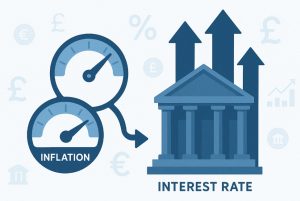
Central banks like the Bank of England play a crucial role in maintaining monetary and financial stability. One of their primary tools for controlling inflation is adjusting the base interest rate.
When inflation rises above the target level, typically 2% for the UK, the Bank of England may increase interest rates to moderate economic activity.
Higher interest rates reduce consumer and business borrowing. This is because:
- The cost of borrowing rises, discouraging loans for major purchases
- Savings become more attractive, encouraging people to defer spending
- Demand across the economy slows, which helps ease price pressures
This method of monetary policy is widely used to prevent inflation from eroding the purchasing power of the currency and to stabilise the economy during periods of excessive price growth.
How Does Rising Inflation Impact Interest Rates in the UK?
Rising inflation plays a central role in shaping interest rate decisions made by the Bank of England. When consumer prices begin to increase at a pace beyond the central bank’s inflation target, currently set at 2% the Bank is compelled to intervene to restore economic balance. One of its most effective tools for doing so is adjusting the base interest rate.
In 2025, the UK economy has experienced renewed inflationary pressure, driven by a range of factors, including higher fuel and food prices, increased utility costs, and persistent supply chain disruptions.
The latest data from the Office for National Statistics revealed that the Consumer Prices Index (CPI) rose to 3.6% in June, up from 3.4% in May. This rise caught analysts by surprise, as most had expected inflation to remain flat.
Why Inflation Influences Interest Rate Policy?
The main objective of interest rate policy is to keep inflation stable and predictable. When inflation rises above the Bank of England’s target, monetary policy becomes tighter, usually through interest rate hikes. This approach aims to reduce demand across the economy, thereby slowing down price increases.
The mechanism works as follows:
- Higher interest rates make borrowing more expensive, discouraging both consumer and business loans
- Savings become more attractive, incentivising people to postpone spending
- Reduced spending leads to lower demand, which in turn helps bring down inflation
By tightening monetary policy through rate increases, the Bank of England seeks to cool down the economy without triggering a full-scale recession.
Inflation Trends and the UK in 2025
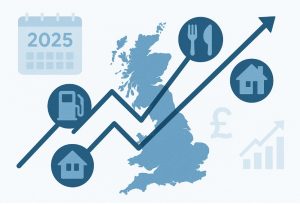
In the current economic climate, inflation is proving to be more stubborn than anticipated. Several components are contributing to this upward trend:
- Food prices have continued to rise for three consecutive months, driven by increases in the cost of cakes, meat, milk, eggs, and cheddar cheese. The annual food inflation rate reached 4.5% in June, the highest since early 2024.
- Fuel costs, although falling on a year-on-year basis, declined at a slower rate than in 2024. This smaller decrease has effectively pushed up the overall annual inflation figure. For example, while petrol prices dropped to an average of 131.9p per litre in June 2025 (down from 145.8p a year earlier), the monthly fall between May and June was only 0.5p, compared with a 3p drop in the same period in 2024.
- Services inflation often considered a more accurate gauge of domestic inflationary pressure remained steady at 4.7% in June, contrary to forecasts of a decline. This was largely influenced by higher air fares and hospitality prices.
These developments suggest that inflation is not solely the result of temporary or external shocks. Instead, it is becoming embedded in the broader economy, particularly in services where wages, rent, and other local costs play a major role.
The Bank of England’s Response
Over the past year, the Bank of England has cut its base interest rate four times, most recently in May 2025, bringing it down to 4.25%. These rate reductions were initially introduced to support growth amid signs of economic slowdown and weakness in the labour market.
However, the unexpected rise in inflation is complicating the Bank’s easing strategy. Further rate cuts are now in question, and the Monetary Policy Committee (MPC) may be forced to delay or even halt future reductions until inflation shows consistent signs of falling back toward the target.
This dynamic illustrates a key aspect of monetary policy: it must remain flexible and responsive to real-time data. Central banks often find themselves walking a tightrope acting too late could allow inflation to spiral, while moving too aggressively could stifle growth and worsen unemployment.
Broader Economic Context
The inflationary environment in the UK is being shaped by a mix of domestic and international factors. While global commodity prices, shipping disruptions, and geopolitical uncertainty continue to influence costs, internal pressures such as government fiscal policy also play a role.
For example, Labour’s economic programme particularly the £25 billion increase in employer national insurance contributions introduced in April, has raised concerns among business leaders. Many argue that such policies increase operating costs, which are then passed on to consumers through higher prices.
At the same time, weak economic growth and a slowing jobs market present challenges to the Bank of England. Official figures suggest the UK economy has contracted for two consecutive months, and the labour market is showing signs of cooling. This creates a conflict: inflation is high enough to justify rate increases, but growth is weak enough to warrant caution.
Table: Inflation Drivers and Monetary Response (UK – 2025)
| Inflation Driver | Description | Monetary Policy Response |
| Food prices | Persistent rises across meat, dairy, and bakery items | Maintain or increase interest rates |
| Fuel and energy costs | Smaller year-on-year drops compared to previous years | Delay further rate cuts |
| Services inflation | Steady at high levels (4.7% in June) | Signals strong domestic inflation; requires vigilance |
| Weak economic growth | GDP stagnation and labour market cooling | Calls for cautious monetary easing |
| Political/fiscal measures | Labour tax reforms and spending plans | Adds complexity to rate decision-making |
This table highlights the difficult balancing act the Bank of England must perform. Inflationary drivers are strong, but so are the risks to economic growth and employment.
How Markets and Lenders React?
The financial markets closely watch inflation data and the Bank of England’s monetary policy decisions. When inflation surprises to the upside, bond markets often respond by pricing in higher interest rates. This has a knock-on effect on mortgage rates, loan products, and investment returns.
Lenders adjust their pricing accordingly. Even if the base rate remains unchanged, expectations of future rate increases can lead banks and building societies to raise mortgage and credit rates pre-emptively.
This affects borrowing costs across the economy and slows demand, contributing further to the Bank’s goal of inflation control, even before official policy changes are implemented.
Implications for Consumers and Businesses
For consumers, rising inflation and interest rate uncertainty create financial strain. The cost of living remains elevated, and borrowing is becoming more expensive. Many households are forced to reconsider discretionary spending and focus on essentials.
For businesses, particularly those in energy-intensive or consumer-facing industries, the inflation-interest rate relationship translates into cost pressure and revenue uncertainty. Firms may struggle to manage cash flow or delay expansion plans due to the unpredictable interest rate environment.
In this way, the rise in inflation not only prompts an increase in interest rates but also creates broader uncertainty that feeds back into the real economy, influencing behaviours, expectations, and financial decisions.
What Are the Economic Consequences of Higher Interest Rates?
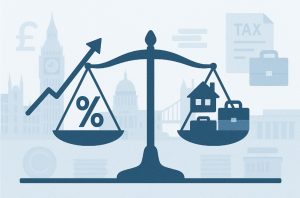
When the Bank of England raises interest rates to control inflation, the ripple effects extend across every part of the economy. While the primary goal is to reduce price pressures by curbing demand, the consequences are far-reaching and can affect everything from individual household budgets to national investment trends.
Impact on Households and Consumers
For most households, the most immediate and visible impact of higher interest rates is the increase in borrowing costs. Those with variable-rate mortgages, credit cards, or personal loans will see their repayments rise as lenders pass on the higher base rate.
Higher interest rates tend to discourage borrowing and encourage saving, which leads to a drop in consumer spending. This can affect the overall economy because the UK is heavily reliant on consumer demand for growth.
When spending slows, businesses experience reduced revenue, which can eventually lead to job cuts or wage stagnation.
Mortgage holders are particularly affected. A family with a £250,000 mortgage on a variable rate could see hundreds of pounds added to their monthly repayments following several percentage point increases. For renters, the knock-on effect is higher rents, as landlords with mortgages pass on their rising costs.
At the same time, households with savings benefit. As interest rates rise, so do the returns on fixed deposits, ISAs, and savings accounts. This can be a small cushion for those not heavily reliant on credit, but it rarely offsets the broader cost-of-living challenges posed by inflation.
Business Sector Challenges
Higher interest rates also create significant headwinds for businesses, particularly small and medium-sized enterprises (SMEs). These businesses often rely on short-term borrowing to finance operations, fund expansion, or manage cash flow.
When borrowing becomes more expensive, business owners may delay or cancel investment plans.
Start-ups and growth-stage companies, in particular, can suffer under tighter credit conditions. In a high-interest environment, venture capitalists and institutional investors tend to become more risk-averse, leading to reduced funding opportunities for innovation and entrepreneurship.
In addition to direct borrowing costs, businesses face reduced consumer demand. As households cut back on spending due to higher borrowing costs, revenue across sectors, especially retail, hospitality, and non-essential services, tends to fall.
This double pressure on costs and revenues can lead to job cuts, lower wages, or slower hiring.
Housing Market Slowdown
Interest rate increases are often accompanied by a noticeable cooling in the housing market. Higher mortgage rates reduce the affordability of home loans, discouraging potential buyers and causing a slowdown in property sales.
Buyers may find that monthly repayments on a new mortgage are significantly higher than in previous years, even if house prices themselves have not increased. This can reduce housing demand and lead to slower price growth, or even price declines in some regions.
For property developers, the higher cost of finance for new projects can result in construction delays or cancellations, impacting the broader construction industry and associated supply chains.
Investment and Stock Market Performance
The financial markets also react to interest rate increases. Equities often come under pressure as investors adjust their expectations for corporate profits, which are typically lower during periods of higher borrowing costs and reduced consumer demand.
At the same time, bond markets respond positively to higher interest rates, as yields on government and corporate bonds increase. This can lead to a reallocation of investment capital away from riskier assets like equities and into fixed-income products.
Investors also tend to favour currencies associated with higher interest rates, leading to an appreciation of the pound. While this can reduce the cost of imports, it may hurt exports by making British goods more expensive abroad.
Public Sector and Government Borrowing
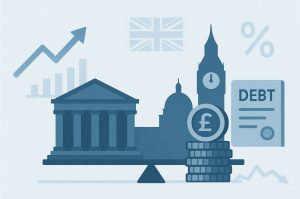
Rising interest rates increase the cost of servicing government debt. The UK government, like many others, issues bonds to finance spending. When interest rates rise, new bonds must offer higher returns to attract investors.
This raises the overall cost of public borrowing, potentially diverting funds from essential services such as healthcare, education, or infrastructure.
Governments must then choose between raising taxes, cutting spending, or increasing deficits each of which carries its own set of economic and political consequences.
For a government already under scrutiny for managing a period of low growth and public dissatisfaction over living costs, rising borrowing costs can further constrain fiscal options.
Table: Summary of Key Economic Consequences of Higher Interest Rates
| Economic Area | Consequence |
| Households | Higher mortgage and loan repayments, reduced spending power |
| Businesses | Increased borrowing costs, delayed investment, lower consumer demand |
| Housing Market | Decline in affordability, slower sales, weaker price growth |
| Investment Markets | Lower equity valuations, higher bond yields, currency appreciation |
| Public Finances | More expensive government debt, potential spending cuts or tax increases |
Disproportionate Impact on Lower-Income Groups
It is also important to highlight that interest rate rises can have a disproportionate impact on lower-income households. These groups often have less savings and are more reliant on credit for essential purchases.
Rising borrowing costs can therefore lead to greater financial strain, increased debt burdens, and in some cases, defaults or evictions.
Economic inequality can widen during periods of high interest rates, as wealthier households benefit from higher returns on savings and investments, while poorer households face a heavier cost of living burden.
Sector-Specific Slowdowns
Certain sectors feel the impact of higher interest rates more acutely. These include:
- Retail and hospitality: Reduced discretionary spending affects footfall and turnover
- Construction and real estate: Fewer buyers and higher finance costs slow down development
- Automotive: Car purchases, often financed through loans, decline when interest rates rise
Each of these sectoral effects contributes to the broader economic slowdown that typically accompanies a sustained period of monetary tightening.
Can Interest Rate Hikes Effectively Curb Inflation?
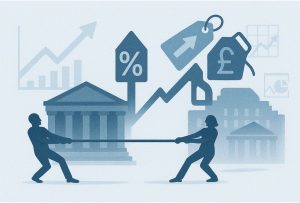
Interest rate increases are an effective tool, but they are not an instant solution. There is a delay between when a rate change is made and when its full effects are felt across the economy.
This time lag can range from 6 to 18 months, depending on economic conditions and consumer behaviour.
The effectiveness of this approach also depends on the causes of inflation. For instance:
- If inflation is demand-driven, such as excessive consumer spending, interest rate hikes are usually effective
- If inflation is supply-side, such as disruptions in global supply chains or energy prices, the impact of rate hikes may be limited
Historically, the Bank of England has used interest rate increases to manage high inflation, including during the early 1990s and again in the aftermath of the global financial crisis.
However, overly aggressive rate hikes risk tipping the economy into a recession if not balanced correctly.
What Factors Influence the Bank of England’s Interest Rate Decisions?
The Bank of England considers a range of domestic and international factors when setting interest rates.
These include inflation trends, employment data, global market conditions, and political developments.
Some of the most influential indicators are:
- Core inflation: Offers a clearer view of underlying price trends by excluding volatile items like energy and food
- Services inflation: Acts as a reliable measure of domestic economic pressure, remaining steady at 4.7% in June 2025
- Employment data: A weakening labour market could ease wage growth and support lower inflation
- Global developments: US trade policies and global commodity prices influence the UK economy
In addition, fiscal decisions made by the government, such as changes to taxation or public spending, play a significant role.
For example, the increase in national insurance contributions introduced in April 2025 is expected to affect both employment and consumer spending patterns.
Are We Expecting More Interest Rate Changes in 2025?
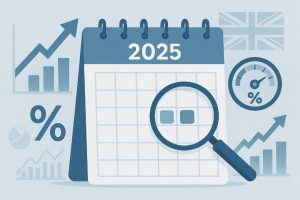
Interest rates in the UK have already been lowered four times in 2025, bringing the base rate to 4.25%. However, the recent rise in inflation has sparked debate about whether further cuts will occur this year.
The Bank of England remains data-dependent, and the possibility of more rate reductions in 2025 largely hinges on whether inflation begins to ease towards the 2% target.
With current projections suggesting a peak of 3.7% in September, further cuts appear unlikely in the near term.
Forecasted Economic Indicators – UK (2025)
| Indicator | Current (June 2025) | Forecast (Q4 2025) | Notes |
| CPI Inflation | 3.6% | 3.2% | Expected to ease slightly by year-end |
| Services Inflation | 4.7% | 4.5% | Remains above Bank of England comfort zone |
| Base Interest Rate | 4.25% | 4.00% | Possible cut if inflation slows |
| GDP Growth (YoY) | 0.2% | 0.5% | Slow recovery forecasted |
| Unemployment Rate | 4.3% | 4.5% | Job market cooling could affect policy |
The UK’s political environment also adds a layer of complexity. The Labour government, under Chancellor Rachel Reeves, has introduced measures to stimulate growth, including infrastructure spending and regulatory reforms.
Yet, business leaders have expressed concerns about tax increases and cost burdens that may dampen recovery.
How Can Households and Businesses Prepare for Interest Rate Changes?
Given the uncertainty surrounding inflation and interest rates, both households and businesses should consider practical steps to protect their financial well-being.
For households:
- Explore fixed-rate mortgage options to reduce future cost volatility
- Limit exposure to high-interest consumer credit
- Build up an emergency fund to manage rising living costs
For businesses:
- Evaluate financing structures to reduce interest-related risks
- Monitor input costs and supply chain contracts
- Delay discretionary capital expenditures until rate outlook stabilises
By proactively adjusting to changing financial conditions, stakeholders can better manage the risks associated with fluctuating interest rates.
What Does the Future Hold for Inflation and Interest Rates?
The path ahead for the UK economy is shaped by persistent inflation, modest growth, and a cautious central bank.
If inflation continues to exceed expectations due to sticky service costs and external price shocks, the Bank of England may be forced to delay or halt its easing cycle.
Economic uncertainty stemming from international politics, including global trade policies and energy prices, will also weigh on future monetary policy decisions.
In the near term, most analysts expect interest rates to remain elevated relative to pre-pandemic norms, even if modest reductions are introduced later in the year.
Policymakers, households, and investors will need to stay attuned to shifting inflationary pressures and prepare accordingly.
Conclusion – What Should You Remember About Inflation and Interest Rates?
Inflation and interest rates are deeply interconnected. When inflation rises, central banks respond by raising interest rates to manage economic stability.
While this can slow price growth, it also impacts borrowing, saving, and investment behaviour across the country.
The current UK economic climate marked by stubborn inflation, cautious central bank policy, and political uncertainty demands vigilance.
Understanding these trends and preparing accordingly can help individuals and businesses make smarter financial decisions in 2025 and beyond.
FAQs About Inflation and Interest Rates
Why doesn’t the Bank of England always raise rates when inflation rises?
Raising rates isn’t always appropriate. If inflation is driven by temporary or external factors, raising interest rates could hurt economic growth without addressing the root causes.
How quickly do interest rate changes affect inflation?
There’s typically a time lag of 6 to 18 months before changes in interest rates fully impact inflation and economic activity.
What’s the difference between CPI and core inflation?
CPI includes all consumer goods, while core inflation excludes volatile items like food and energy, giving a clearer view of long-term trends.
How does global inflation impact UK interest rates?
Imported inflation from higher global prices such as oil or food can influence domestic inflation, prompting the Bank to adjust rates accordingly.
Will inflation in 2025 affect mortgages in the UK?
Yes, continued inflation may lead to higher mortgage rates, especially for variable-rate or new borrowers. Fixed-rate holders may be shielded temporarily.
What role does government policy play in inflation control?
Fiscal policies, such as tax changes or wage support, can impact disposable income and consumer demand, indirectly influencing inflation.
Is deflation ever a risk after aggressive rate hikes?
Yes, if rates rise too quickly, demand may fall sharply, leading to deflation a prolonged period of falling price.








